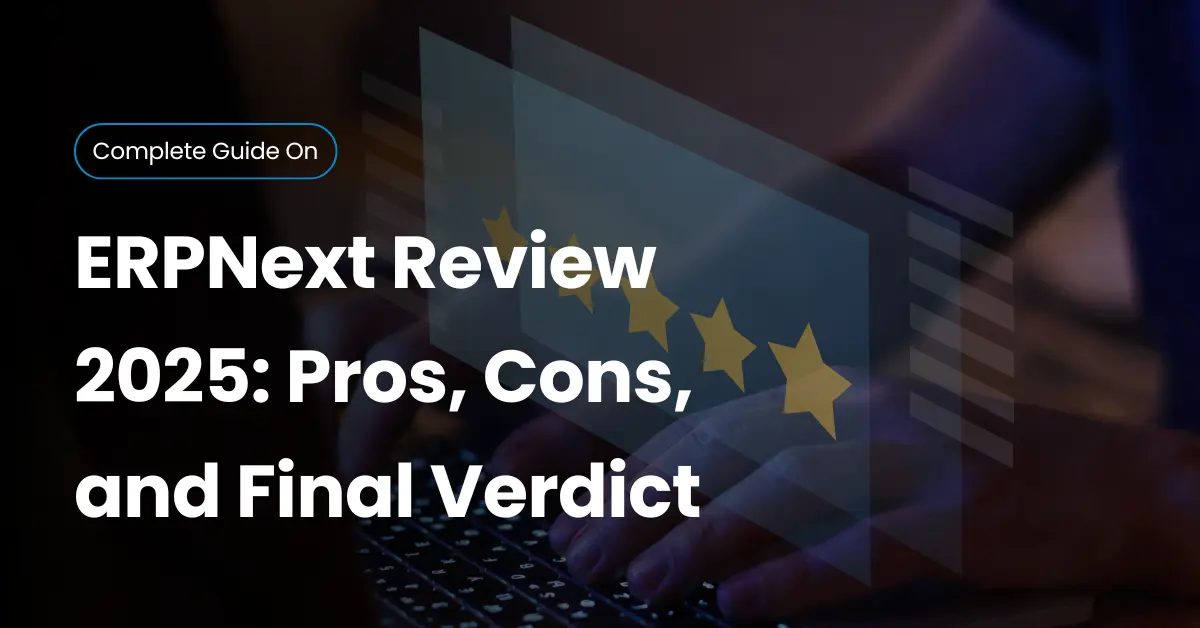If you’re running a manufacturing business in the US, 2025 probably feels like a juggling act. Supply chain disruptions, compliance audits, and rising labor costs are hitting hard. Staying competitive isn’t just about producing faster—it’s about running smarter.
That’s where ERP (Enterprise Resource Planning) comes in. It’s no longer optional; it’s the backbone of modern operations. Among the many choices out there, in this ERPNext review, we took a look at open source ERP solutions and features in 2025. Which ERP has carved out a reputation as an affordable, flexible, and future-ready manufacturing ERP? According to Infintrix Technologies, US SMEs are adopting open-source ERP solutions faster than ever, and ERPNext is leading the pack.
Challenges for US Manufacturers in 2025
Manufacturers today face a perfect storm: labor shortages, global supply chain instability, and tougher regulations. Add to that the demand for faster delivery and lower costs, and you’ve got an industry under constant pressure.
Traditional ERP systems often make things worse with high fees and clunky setups. That’s why more US businesses are actively searching for open-source ERP options that adapt quickly without draining budgets.
Why ERP Adoption is Accelerating
Companies aren’t moving to ERP for “nice-to-have” reasons anymore—it’s survival mode. The pace of ERP adoption has doubled in the last three years, and here’s why:
- Rising costs force leaders to track every dollar.
- Supply chain issues push for better forecasting.
- Compliance audits demand accurate, real-time reporting.
For example, a small auto-parts manufacturer in Ohio recently turned to ERPNext to reduce stockouts. Within six months, they cut lost production days by 18%. That kind of ROI gets attention fast.
ERPNext as a Cost-Effective, Flexible Choice
Here’s the thing: legacy ERP vendors like SAP and Oracle often price themselves out of reach for small and mid-sized manufacturers. ERPNext flips that script. It’s free at the base level, with optional costs for hosting, support, and customization.
That makes ERPNext especially attractive to SMEs who need full-featured manufacturing ERP software without massive licensing fees. Its open-source foundation (built on Frappe) also means developers can adapt it quickly to fit unique production workflows. Flexibility plus affordability? That’s a hard combo to beat in 2025.
What is ERPNext? A Complete Overview for Manufacturers
Think of ERPNext as a digital control room for your factory. It’s an open-source ERP that ties together everything from HR and finance to production planning and supply chain tracking. Instead of juggling spreadsheets and siloed apps, you get one unified system.
That simplicity is what makes ERPNext stand out for US SMEs. It delivers enterprise-level power without locking you into expensive contracts. And because it’s open-source, you have the flexibility to adapt it as your business grows.
Core Modules & Capabilities
- Finance, HR, and CRM for everyday operations
- Manufacturing, inventory, and supply chain tools
- Compliance and reporting modules built for audits
Cloud vs On-Premise Options
Cloud hosting means fast deployment and lower upfront investment — perfect ERP for SMEs that want to move quickly. On-premise setups, on the other hand, give full control over data, which is ideal for compliance-heavy sectors like aerospace and defense.
Key Features of ERPNext for Manufacturing in 2025
Here’s the heart of this ERPNext review 2025: the features that manufacturers actually use every day. Unlike some competitors, these tools come built-in, so you’re not chasing down extra add-ons.
1. Production Planning & Scheduling
ERPNext aligns sales orders with available capacity. That means fewer bottlenecks, better machine usage, and smarter workforce allocation.
2. Bill of Materials (BOM) Management
Multi-level BOMs are no problem here. ERPNext tracks costs, materials, and availability in real time—critical when you’re running complex production lines.
3. Material Resource Planning (MRP)
With automated reordering, you don’t waste cash on excess stock or stall production due to shortages. That balance directly improves ROI.
4. Analytics, Mobility & Real-Time Tracking
AI dashboards give you instant insights, while ERPNext’s mobile apps keep supervisors connected—even on the shop floor or away from the facility.
ERPNext vs Traditional ERP Systems
Comparisons matter, especially when budgets are tight. Here’s how ERPNext stacks up against SAP Business One, Microsoft Dynamics 365, and Odoo in 2025:
| Feature | ERPNext (Open Source) | SAP Business One | Microsoft Dynamics 365 | Odoo |
| Licensing Cost | Free (support optional) | High | Subscription-based | Freemium + paid apps |
| Manufacturing Modules | Built-in | Add-on | Requires customization | Strong but fragmented |
| Customization | Flexible, open-source | Limited | Moderate (within MS suite) | Wide app ecosystem |
| Scalability (SMEs → Mid) | Strong | Best for large enterprises | Enterprise scale | Strong community support |
Here’s the key takeaway: while SAP and Dynamics are powerful, they’re often overkill (and overpriced) for small to mid-sized US manufacturers. Odoo is popular, but its ecosystem can feel fragmented. ERPNext hits the sweet spot—affordable, built for manufacturing, and endlessly adaptable.
How Much Does ERPNext Cost in 2025?
Pricing is one of the biggest reasons manufacturers give ERPNext a second look. Unlike traditional ERP systems, you’re not locked into steep licensing fees. The ERPNext pricing model is based on whether you host it yourself or choose cloud deployment.
Open-Source Base Software
The core software is free. What you pay for are setup, hosting, and customization. Many US SMEs love this because it gives them control over costs from day one.
Cloud vs On-Premise Costs
Cloud hosting usually means predictable monthly fees and quick deployment. On-premise hosting requires servers and an IT team but offers maximum control—especially valuable for compliance-heavy industries.
Total Cost of Ownership (TCO)
- 40–60% lower than SAP or Oracle over 5 years
- No mandatory licensing fees
- Costs tied to customization and support, not usage penalties
Benefits of ERPNext for US Manufacturers
Here’s where ERPNext proves its worth. Beyond low pricing, it delivers the kind of manufacturing ERP benefits US businesses need: efficiency, compliance, and measurable ROI.
1. Streamlined Production Processes
Everything connects—BOMs, scheduling, work orders—so production flows with fewer hiccups.
2. Inventory & Supply Chain Optimization
Smart alerts and demand forecasting help you avoid costly stockouts or bloated inventory. Vendor management tools make supplier relationships more transparent.
3. Cost Efficiency & ROI
One of our clients reported cutting ERP expenses by 35% in year one. Faster reporting also boosted productivity by 20%. That’s the kind of ROI CFOs love.
4. Compliance & Audit Readiness
With FDA and ISO templates built in, ERPNext helps manufacturers stay audit-ready. It also tracks materials for recalls, which can be a lifesaver in regulated industries.
Challenges of ERPNext Implementation (and How to Overcome Them)
No ERP system is a magic button. The real test is in ERPNext implementation. The good news? With the right partner, even tricky steps can be handled smoothly.
Data Migration from Legacy Systems
Moving from outdated systems can be messy. The fix: plan migrations in phases and validate data at each stage.
User Training & Adoption
ERP is only as strong as the people using it. Role-based onboarding and phased rollouts make adoption less overwhelming.
Customization vs Complexity
Flexibility is great, but over-customizing can slow future updates. The key is balancing unique needs with sustainability.
This is where Infintrix Technologies shines. They simplify data migration, train staff effectively, and set you up for long-term success with ERPNext.
Industry-Specific Use Cases for ERPNext
Every manufacturer has different challenges. That’s why ERPNext’s flexibility matters—it adapts to specific industries without forcing expensive add-ons.
Automotive Manufacturing
- Supplier management for complex part networks
- Full production traceability
- Real-time parts inventory control
Food & Beverage
- FDA compliance tracking built in
- Shelf-life monitoring and recall management
- Safer supply chain visibility for perishable goods
Aerospace & Defense
- Precision BOM accuracy for high-complexity builds
- Audit-ready compliance records
- Secure documentation management for regulatory oversight
Why Infintrix Technologies is a Trusted ERPNext Partner
Software alone doesn’t guarantee success—partnership does. Infintrix Technologies has proven experience guiding US manufacturers through ERPNext adoption from planning to post-launch.
- Deep ERPNext expertise for compliance-heavy industries
- Tailored implementation strategies for SMEs
- Continuous support long after go-live
- Client success stories with measurable ROI
That experience is what helps manufacturers move from uncertainty to confidence when adopting ERPNext.
Conclusion: Is ERPNext the Right ERP for Your Business in 2025?
By 2025, US manufacturers don’t have the luxury of wasting money on outdated tools. ERPNext offers a rare combination: open-source affordability, manufacturing-specific modules, and the flexibility to grow with your business. Compared to SAP, Dynamics, and Odoo, it’s a strong contender for SMEs needing real results without enterprise-level price tags.
Still, ERPNext isn’t plug-and-play.
Choosing the right implementation partner makes the difference between frustration and ROI. With a track record of simplifying migrations, training teams, and optimizing ERPNext for real-world manufacturing, Infintrix Technologies has become the go-to partner for US businesses ready to scale smart.
If you’re weighing options, a tailored consultation could be the step that helps you decide whether ERPNext is the right fit for 2025 and beyond.
FAQs About ERPNext in 2025
Is ERPNext suitable for small US manufacturers?
Yes. Its open-source foundation and modular design make it ideal for SMEs.
How much does ERPNext implementation cost?
The software is free. Costs depend on hosting, customization, and ongoing support.
Can ERPNext help with FDA and ISO compliance?
Absolutely. ERPNext comes with templates and tracking features for regulated industries.
How long does ERPNext implementation take?
Most projects run 3–6 months, depending on complexity and training.
Why choose Infintrix Technologies as an ERPNext partner?
They provide end-to-end support—from strategy to training—so businesses get value fast.

